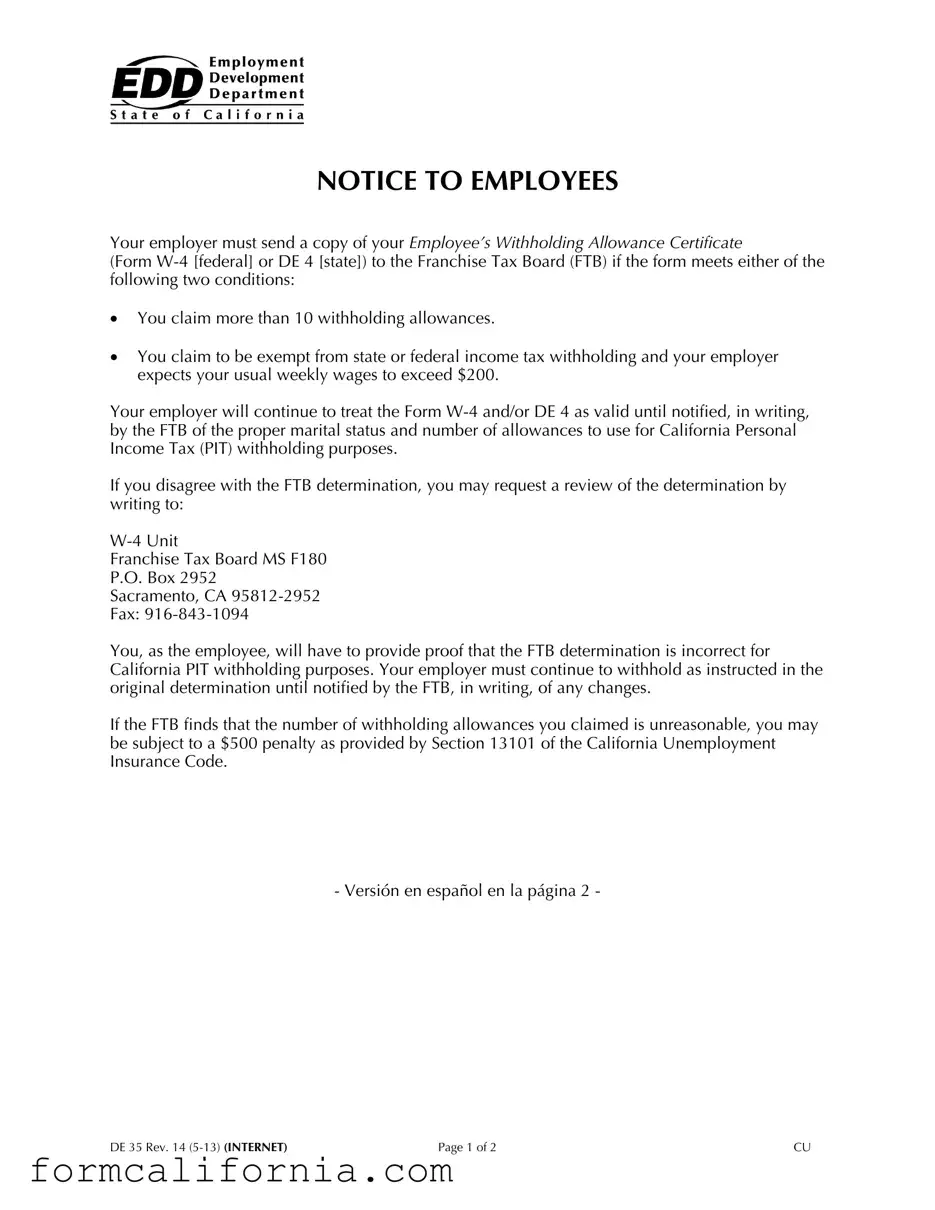The Federal W-4 form, akin to the California DE 4 form, serves as an Employee’s Withholding Allowance Certificate on a national level. Both documents are vital for determining the amount of federal or state income tax to withhold from an employee's paycheck. Employees specify their marital status, number of allowances, and any additional amount to be withheld. The critical similarity between these documents is their role in ensuring the correct amount of tax is withheld, aligning with the taxpayer's circumstances and mitigating the risk of under or overpaying taxes throughout the fiscal year.
Form W-2, or the Wage and Tax Statement, while serving a different purpose, shares a connection with the CA DE 35 form through the flow of information. The W-2 is issued by employers to both the employee and the IRS at year-end, summarizing annual wages and the amount of taxes withheld. It is the data claimed on forms like the W-4 or DE 4 that directly influences the figures reported on the W-2. Thus, while the DE 35 form communicates an employee’s withholding preferences to the tax authorities, the W-2 completes the cycle by documenting the outcome of those choices.
The I-9 form, or Employment Eligibility Verification, though primarily focused on verifying an employee's legal right to work in the United States, also ties back to payroll processes informed by forms like the CA DE 35. Employers must ensure that employees are authorized to work and thus eligible for legitimate payroll setup, which includes tax withholdings calculated based on the employee's W-4 or DE 4 information. The connection between these documents lies in their shared objective to regulate and legitimize employment and its financial aspects in compliance with federal and state laws.
Schedule C (Form 1040 or 1040-SR), used by sole proprietors to report profits and losses from a business, relates indirectly to the CA DE 35 form paradigm. While CA DE 35 pertains to employee withholding, Schedule C captures the business owner's income and expenses, potentially influencing their personal tax situation and withholding needs if transitioning from or to an employee role. The linkage is in the overarching landscape of tax obligations, where decisions on one form can impact the relevancy and accuracy required on another.
The 1099-MISC form, which reports miscellaneous income, can be associated with the CA DE 35 form through its impact on an individual's total tax liability. Independent contractors, unlike traditional employees who use forms like DE 35 for withholding allowances, receive 1099-MISC forms that reflect income not subject to withholding. This situation underscores the informational interplay between varied tax documents; while one delineates income and tax withheld at source, another outlines additional income streams affecting the taxpayer's overall financial portrait for accurate tax reporting and payment.
Form 941, the Employer's Quarterly Federal Tax Return, plays a collaborative role with the CA DE 35 in the broader scheme of employment taxes. This form is where employers report the total wages paid, tips earned by employees, and the withholding of federal income, Social Security, and Medicare taxes based on information provided in forms like the W-4 or DE 4. The connection between these documents underscores a cycle of tax reporting and remittance, reinforcing the interdependence of various forms to maintain tax compliance and financial accountability within the payroll process.
The Employee’s State Insurance Form (ESI), though more specific to health insurance and social security benefits in certain countries outside the United States, shares conceptual similarities with the CA DE 35 form regarding employee welfare and deductions. Both forms are instrumental in determining deductions from an employee's salary – in the case of the ESI for insurance and social security contributions, and for CA DE 35, tax withholdings. Despite their different purposes, each plays a crucial role in managing employee earnings and ensuring contributions to mandatory programs, highlighting their role in the broader constellation of employment-related documentation.


